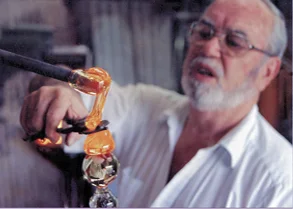Robert Hamon's work has been featured in numerous shows and galleries, and earned the artist many awards, over his lifetime. In 1998, his Study Of Earth Elements And Fire, appeared in a juried exhibit sponsored by the Marshall University Graduate College. I had the privilege of seeing his sculpture there, and have never forgotten it.
The entry consisted of three blown bowls, each a different color, but positioned together, as if petals blooming from the same flower. The bowls are streaked with white and colored stripes, but their predominant colors are maroon, grey and blue. The exhibit was 28" by 32". For the show catalog, it was photographed from above, using light boxes and umbrellas to soften the light and reduce unwanted reflections. It took weeks of hard work to produce the bowls, finish and polish them.
Planning The Piece
I remember discussing the bowls with my uncle during the planning phase. He wanted the blown bowls to be irregular in shape, and each different, but to fit together seamlessly. Even for a seasoned glassblower, it was a challenge getting the shapes the way he wanted, and to find the exact color combinations he envisioned. The final challenge was to arrange them in just the right manner. The final result wa a hit.
There were many wonderful pieces in the show -- and many quite imaginative -- but my uncle's sculpture was one of the most popular, and aesthetically pleasing. An example of beautiful and gently refined art glass.
The bowls were free-blown, heated in, spun and flared out. He did a little cutting to get the asymmetrical shape, and he positioned the sides to achieve a lobsided look. I was fortunate enough to watch him blow the bowls, and my heart raced with excitement as he turned the rod and the thin glass fluttered in mid-air. It seemed the bowls would fly off the pipe at any moment and land in the middle of the studio floor!
A Background In Glass
Robert began learning the art of free-form and mold-blowing in his father's glass factory at the age of 10. At the age of 12, he became known as the youngest free-blown chimney maker in the world. He honed his skills by making communion glasses for churches in the United States, along with crystal stem ware.
Eventually, he became the head glass blower at Pilgrim Glass in Huntington, West Virginia and taught glass finishing there. Robert was driven to be the best he could be, and served as Chief Designer and Glass Chemist at the family enterprise, Hamon Glass Company.
In the mid 1960s, Hamon purchased the family business and became plant manager. He became the glass designer for Kanawha Glass, after it merged with Hamon Glass. Along the way, he continued to sharpen his glass blowing skills. In 1969, he started his "Artist Series" of glass, in which he made commissioned pieces and developed his first glass sculptures. The art glass grew steadily and, from that point on, he was dedicated to making various collections.
A Passion For Color And Movement
Many admirers have told me they feel Robert L. Hamon's glass is alive. It has energy or spirit... and moves inside the viewer.
I am looking at a small sculpture he made as a gift for me when I opened my first psychotherapy practice in the early 1980s. It was intended to sit on my desk or a table in my office. And that's where it sits now -- in my current office. He wanted it to inspire my clients and to elicit an emotional response. It was designed to appeal to the unconscious mind and probe one's inner resources, a feat which it has proven to accomplish on numerous occasions.
The Glass Artist's Highest Aspiration
The mostly crystal sculpture with light blue, cobalt, red and white glass ribbons inside, roughly resembles a ghost in shape, with four small protrusions, almost like small fins or flippers, emanating at various angles from the elongated body. It is one heckuva conversation piece!
Light reflects on the shiny surface and passes through it, often mingling with the grain of the wood in my desk and the cottony texture of nearby papers and reports.
The free-formed sculpture has no name, although he and I tried to find a suitable one. I have chosen to leave it untitled, and to think of it in a way that goes beyond the limits of mere words. Although the piece is not as grand as some in my collection, it is my most cherished. Encapsulated in that sculpture is the glass artist's hope for all humankind: to look within and discover hidden realities that would lead to an understanding of our greatest potential.
Since displaying the Hamon sculpture in my office in the early 1080s, countless individuals have seen the piece. Their comments are too humorous to list here, but I will say the solid glass piece has generated an enormous amount of curiosity, over the years. Many of my adolescent clients have enjoyed trying to figure out what it is, or what Bob intended it to be. They always look for hidden themes and arcane meanings -- a fact that would please my uncle.
Discover More About Robert L. Hamon's Glass
You can sometimes find Bob's glass on e-bay at other locations. I hope you'll visit his new website to learn more about my talented and enigmatic uncle, who sadly passed away a few years ago. But his legacy, and the legacy of Hamon Glass, lives on.
-- Richard Hamon II
